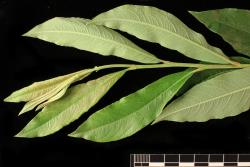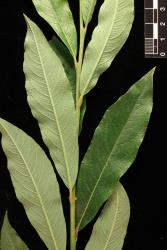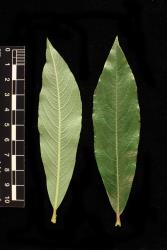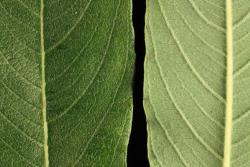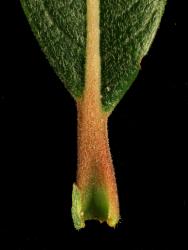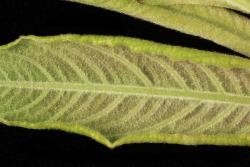- ≡ Salix myrsinites Hoffm., Hist. Salic. Ill. 1, 71 (1787) nom. illeg., non Salix myrsinites L. 1753
- = Salix nigricans Sm., Trans. Linn. Soc. London 6: 120–121 (1802)
Branch wood with ridges sparse to moderate in density and length, 3–12 mm long). Current year's branchlets densely tomentose, hairs erect and almost straight (hispid), greyish brown (UCL61). Flower buds 4.5 mm long, ovoid, 2-angled, dark greyish red (UCL20), with moderately dense short-silky hairs. Leaves alternate. Stipule 4–11 mm long, asymmetrically ovate, persisting. Petiole 7–17 mm long, densely tomentose, glands absent, base yellow-green. Emerging leaves green, with sparse long-silky hairs on midvein, a mixture of brown and silver hairs. Proximal leaves entire. Leaf lamina 50–155 mm long, 22–70 mm wide, length to width ratio 1.7–3.0:1, narrowly elliptical to obovate, not falcate; base cuneate; apex obtuse, sometimes acuminate, leaf galls absent; margins crenate to coarsely serrate, finely revolute; upper lamina surface slightly bullate, slightly glossy, glabrous except midvein base moderately densely tomentose, stomata absent; lower lamina surface midvein and side-veins raised, netted veins raised, distinctly glaucous, glabrous or moderately densely tomentose on midvein only. Catkins emerging coetaneously with leaves. Flowering branch 30–50 mm long with 3 reduced leaves. Female catkin 34–40 mm long, 7–9 mm diameter; catkin rachis visible between flowers. Flower bracts 2.0–3.4 mm long, 0.6–1.0 mm wide, entirely dark brown or brown to near the bract base, flat; apex obtuse, long-silky hairs on both surfaces and margins. Female nectary 1, 0.8 mm long, 0.5 mm wide, yellow; ovary 2.8 mm long, glabrous; stipe 1.7–2.0 mm long; ovary apex tapering to style base 0.8–1.0 mm long, style arms 0.4–0.5 mm long, bilobed 0.1 mm, stigmatic surfaces green.
The diagnostic features of this species are the branchlet hairs, which are short and erect (hispid); the flower bract, which is uniformly brown; the ovary, which is glabrous, on a stipe 0.8 mm long, and tapers evenly to the style, which is also 0.8 mm long, and the style arms are lobed about half their length; and the stipules, which are are persistent and 4–11 mm long. Leaves are obovate and have a petiole 7–10 mm long; both leaf surfaces have medium-dense short-silky hairs, persisting on older leaves only on the midvein.
Similar to Salix eriocephala and S. eriocephala × S. petiolaris in size and shape of leaves. Similar to S. myricoides but lacking the brown leaf hairs of that species, and the ovary is glabrous (some hairs are present at the ovary apex or stipe in S. myricoides ).
In cultivation in Southern North Island (Aokautere and Massey, PN205 and PN267), Canterbury (Christchurch Botanic Gardens 1970).
First collection: CHR 188375, A.J. Healy 70/7, 25 January 1970, Te Hae Hae Te Moana Gorge.
First publication: This publication.
Flowering: Mid-September–early December.
Hexaploid, 2n = 114 (CCDB, based on 13 counts). Flow cytometry using PN205 is ambiguous as to whether it is triploid or tetraploid.



